Flag of Albania
| Use | National flag |
|---|---|
| Proportion | 5:7 (1:1.4 in the law) |
| Adopted |
28 November 1443[1] 28 November 1912 7 April 1992 |
| Design | A red field with the black double-headed eagle in the center. |
The flag of Albania is a red flag with a silhouetted black double-headed eagle in the center. The red stands for bravery, strength and valor, while the double-headed eagle represents the sovereign state of Albania. The flag was first adopted as the national flag of modern Albania in 1912.
History
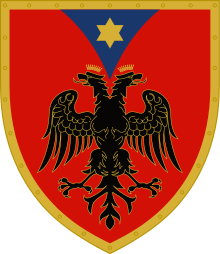
The elements of the flag's design such as the double-headed eagle were borrowed from the banner of the Byzantine Empire.[4][5][6] The eagle was used for heraldic purposes in the Middle Ages by a number of noble families in Albania and became the symbol of the Albanians.[7] The Kastrioti's coat of arms, depicting a black double-headed eagle on a red field, became famous when he led a revolt against the Ottoman Empire resulting in the independence of Albania from 1443 to 1479. This was the flag of the League of Lezhë, which was the first unified Albanian state in the Middle Ages and the oldest Parliament with extant records.[8][9][10][11]
The symbol of the double-headed eagle was re-used by Albanian nationalists during the 18th, 19th and early 20th centuries as a symbol of their campaign for their country's independence from the Ottoman Empire.[4][7] On 28 November 1912, the Albanian Declaration of Independence was proclaimed in Vlora and the flag, raised by Ismail Qemali, was adopted as the symbol of the new nation.[4][7]
The Albanian flag has gone through a number of changes over the years as different regimes have modified it. During the reign of King Zog (r. 1928–1939), a crown was added to the flag and was replaced by two fasces during the Italian occupation of Albania. After World War II, the communist regime added a five-pointed golden star, which was removed on 7 April 1992 after the communist government in Albania collapsed.
Albania's maritime flags—the civil ensign and the naval ensign—are both different from the national flag. The civil ensign consists of three horizontal bands of red, black, and red. The naval ensign is similar to the national flag, except that the eagle is on a white field, and the lower portion of the flag has a red stripe. The eagle of the flag of Albania is depicted on the reverse of the Albanian five lekë coin, issued in 1995 and 2000.[12]
Beginning in 1969, the flag of Albania was widely unofficially flown in Kosovo by the country's ethnic Albanian population.[13] It was the symbol of the unrecognized Republic of Kosova during the 1990s. The current independent state of Kosovo uses a different flag that was designed to avoid any symbols associated with a particular ethnic group.
Incorrect version
There is an incorrect version of the flag still commonly used by Albanians and officials, most notably used in 100th Anniversary of the Independence of Albania, in which the eagles were very noticeably deformed. The flags were ordered from a Chinese company that produced incorrect details. These flags were quickly removed after Independence day, but a few specimens can still be found.[14]
Gallery
Chronological
.svg.png) Flag used during the Albanian National Awakening in the 19th and early 20th centuries.[15]
Flag used during the Albanian National Awakening in the 19th and early 20th centuries.[15].svg.png) Flag of Independent Albania (1912–1914).
Flag of Independent Albania (1912–1914). Alternate flag of Independent Albania (1912).
Alternate flag of Independent Albania (1912)..svg.png) Flag of the Principality of Albania (1914–1920).
Flag of the Principality of Albania (1914–1920). De facto flag of the Principality of Albania (Sep 1914-1915).
De facto flag of the Principality of Albania (Sep 1914-1915)..svg.png) Flag of the Principality of Albania (1920–1925) and the Albanian Republic (1925–1926).
Flag of the Principality of Albania (1920–1925) and the Albanian Republic (1925–1926)..svg.png) Flag of the Albanian Republic (1926–1928).
Flag of the Albanian Republic (1926–1928)..svg.png) Flag of the Albanian Kingdom (1928–1939).
Flag of the Albanian Kingdom (1928–1939)..svg.png) Flag of the Albanian Kingdom under Italy (1939–1943).
Flag of the Albanian Kingdom under Italy (1939–1943)..svg.png) Flag of Albania under German occupation.
Flag of Albania under German occupation..svg.png) Flag of the Democratic Government of Albania (1944–1946)
Flag of the Democratic Government of Albania (1944–1946).svg.png) Flag of the People's Socialist Republic of Albania (1946–1992).
Flag of the People's Socialist Republic of Albania (1946–1992). Flag of the Republic of Albania (1992–current).
Flag of the Republic of Albania (1992–current).
Ensign and standard
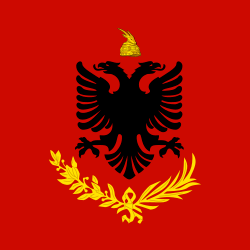 Insignia of the Royal Albanian Army.
Insignia of the Royal Albanian Army..svg.png) Civil ensign of Albania (1945–1992).
Civil ensign of Albania (1945–1992)..svg.png) Naval ensign of Albania (1946–1954).
Naval ensign of Albania (1946–1954)..svg.png) Naval ensign of Albania (1954–1958).
Naval ensign of Albania (1954–1958)..svg.png) Naval ensign of Albania (1958–1992).
Naval ensign of Albania (1958–1992)..svg.png) State ensign of Albania (1958–1992).
State ensign of Albania (1958–1992). Coast Guard ensign of Albania (1958–1992).
Coast Guard ensign of Albania (1958–1992). Presidential Standard (1946–1992).
Presidential Standard (1946–1992)..svg.png) Presidential Standard (1992–2014).
Presidential Standard (1992–2014). Civil ensign of Albania (1992–present).
Civil ensign of Albania (1992–present). Naval ensign of Albania (1992–present).
Naval ensign of Albania (1992–present). State ensign of Albania (1992–present).
State ensign of Albania (1992–present). Coast Guard ensign of Albania (1992–present).
Coast Guard ensign of Albania (1992–present).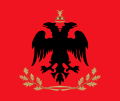 Presidential Standard (2014–present).
Presidential Standard (2014–present).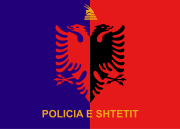 Flag Albanian Police (present).
Flag Albanian Police (present).
Other
 Flag of Albanian Muslims of the first quarter of the 19th century
Flag of Albanian Muslims of the first quarter of the 19th century_Merchant_Flag_1453-1793.svg.png) Latin (usually Albanian) Merchant Flag 1453–1793 during Ottoman Albania.
Latin (usually Albanian) Merchant Flag 1453–1793 during Ottoman Albania. Republic of Central Albania, short-lived unrecognised state created by Essad Pasha Toptani.
Republic of Central Albania, short-lived unrecognised state created by Essad Pasha Toptani. Autonomous Albanian Republic of Korçë, an autonomous state.
Autonomous Albanian Republic of Korçë, an autonomous state. Flag of the Republic of Mirdita, a short-lived, unrecognized republic created by Marka Gjoni.
Flag of the Republic of Mirdita, a short-lived, unrecognized republic created by Marka Gjoni..svg.png) Flag of Albania under Italy (1939–1943), crowned version of the House of Savoy.
Flag of Albania under Italy (1939–1943), crowned version of the House of Savoy.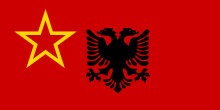 Flag of Socialist Federal Republic of Yugoslavia Albanian Minority (Socialist Autonomous Province of Kosovo).
Flag of Socialist Federal Republic of Yugoslavia Albanian Minority (Socialist Autonomous Province of Kosovo). Flag of the Republic of Kosova.
Flag of the Republic of Kosova.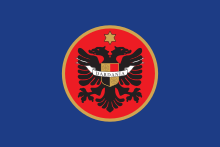 Flag of Dardania, which served as a flag of the Republic of Kosova, and Presidential Flag under UNMIK, created by Ibrahim Rugova.
Flag of Dardania, which served as a flag of the Republic of Kosova, and Presidential Flag under UNMIK, created by Ibrahim Rugova.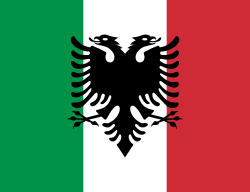 Flag used by Arbëreshë (unofficial).
Flag used by Arbëreshë (unofficial).
 Flag of the Republic of Kosovo (2008–current).
Flag of the Republic of Kosovo (2008–current).
Represents Kosovo Albanians and the 5 minorities in Kosovo.
See also
References
Citations
- ↑ THE 5 OLDEST COUNTRY FLAGS IN THE WORLD, Patriot Wood, LLC, 2015-03-29
- ↑ Hodgkison, Harry (2005). Scanderbeg: From Ottoman Captive to Albanian Hero. ISBN 1-85043-941-9.
- ↑ The Flag Bulletin. Flag Research Center. 1987-01-01.
History records that the 15th century Albanian national hero, Skanderbeg (i.e. George Kastriota), had raised the red flag with the black eagle over his ancestral home, the Fortress of Kruje
- 1 2 3 Elsie 2001, "Eagles", p. 78.
- ↑ Grumeza 2010, p. 99: "During John Hunyadi's campaign at Niss in 1443, Skanderberg and a few hundred Albanians defected from the Turkish ranks; for twenty-five years he scored remarkable victories against the Ottomans. He adopted the Byzantine double-headed eagle flag, and his spectacular victories brought him the papal title Athleta Christi."
- ↑ Mucha, Crampton & Louda 1985, p. 36.
- 1 2 3 Elsie 2010, "Flag, Albanian", p. 140: "The eagle was a common heraldic symbol for many Albanian dynasties in the Late Middle Ages and came to be a symbol of the Albanians in general. It is also said to have been the flag of Skanderbeg...As a symbol of modern Albania, the flag began to be seen during the years of the national awakening and was in common use during the uprisings of 1909-1912. It was this flag that Ismail Qemal bey Vlora raised in Vlora on 28 November 1912 in proclaiming Albanian independence."
- ↑ Matanov 2010, p. 363.
- ↑ Pickard & Çeliku 2008, p. 16.
- ↑ Schmitt 2009.
- ↑ "Kuvendi i Lezhës (1444)". letersia.fajtori.com (in Albanian).
- ↑ "Albanian coins in circulation – Issue of 1995, 1996 and 2000". Bank of Albania. 2004–2009. Retrieved 9 March 2012.
- ↑ Malcolm 1998, p. 325.
- ↑ "Festë me flamuj të deformuar" (Press release) (in Albanian). Top Channel. 22 November 2012. Retrieved 25 November 2012.
Shqipëria po përgatitet të festojë 100-vjetorin e Pavarësisë me simbole të deformuar.
- ↑ "Albania: Ottoman rule (15th century-1912)". Retrieved 4 March 2015.
In the 19th century, the Albanian independentist circles used a red flag with the Byzantine double-headed eagle, supposedly used by the Albanian medieval hero Skanderbeg, and never forgotten in Albania. This flag was also used by the Albanian chief Isa Boletin, when he rebelled against Turkey in 1910. When the Autonomous Government was proclaimed in Mirditë in June 1911, this was also the flag used.
Sources
- Elsie, Robert (2010). Historical Dictionary of Albania. Lanham, MD: Scarecrow Press (The Rowman & Littlefield Publishing Group Incorporated). ISBN 0-8108-6188-7.
- Elsie, Robert (2001). A Dictionary of Albanian Religion, Mythology, and Folk Culture. New York, NY: New York University Press. ISBN 0-8147-2214-8.
- Grumeza, Ion (2010). The Roots of Balkanization: Eastern Europe C.E. 500–1500. Lanham, MD: University Press of America. ISBN 0-7618-5134-8.
- Malcolm, Noel (1998). Kosovo: A Short History. London: Macmillan. ISBN 0-333-66612-7.
- Matanov, Christo (2010). The Oxford Encyclopedia of Medieval Warfare and Military Technology. Oxford: Oxford University Press. ISBN 978-0-19-533403-6.
- Mucha, Ludvík; Crampton, William; Louda, Jiří (1985). Webster's Concise Encyclopedia of Flags & Coats of Arms. New York, NY: Crescent Books. ISBN 0-517-49951-7.
- Pickard, Rob; Çeliku, Florent (2008). Analysis and Reform of Cultural Heritage Policies in South-East Europe. Strasbourg: Council of Europe Publishing. ISBN 978-9-28-716265-6.
- Schmitt, Oliver Jens (2009). Skanderbeg: Der neue Alexander auf dem Balkan (in German). Regensburg: Verlag Friedrich Pustet. ISBN 978-3-7917-2229-0.
Further reading
- Frashëri, Kristo (2002). Gjergj Kastrioti Skënderbeu: Jeta dhe Vepra, 1405–1468 (in Albanian). Tirana, Albania: Botimet Toena. ISBN 99927-1-627-4.
External links
| Wikimedia Commons has media related to Flags of Albania. |

